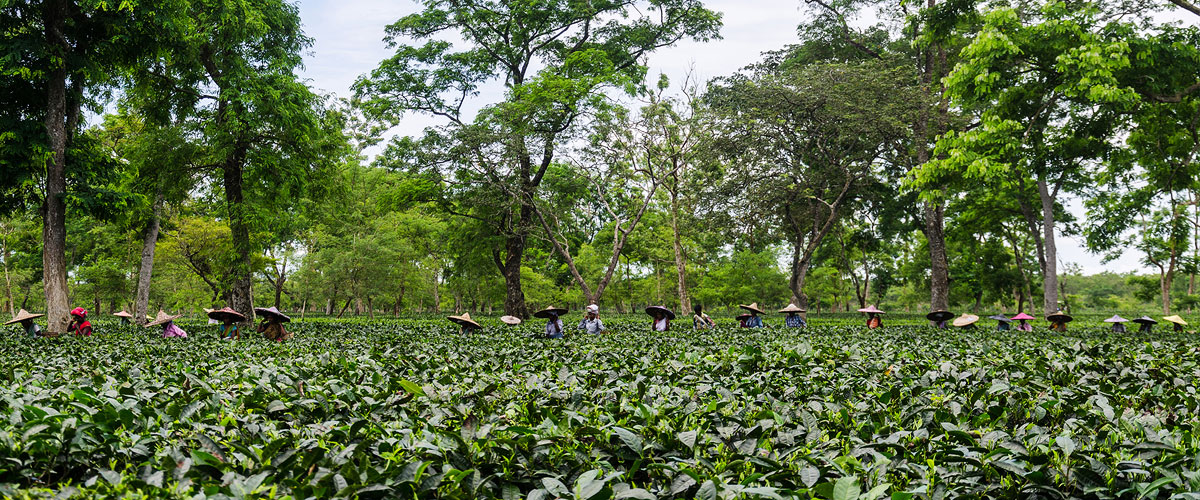Imagine my excitement when I heard that we’ll be spending the day with the estate manager of one of the best tea estates in the country on my visit to Assam. I was intrigued and just a little nervous, because after learning whatever I had at Teabox, I knew the tea business was no joke.
We were scheduled to reach Halmari by 5pm. And we did. Except, as it turned out, there are two Halmari tea estates in Assam, about 180 km apart. We were not in the right Halmari. It was late in the evening and we arrived to a very worried Mr and Mrs Arora, who’d spent the better part of their evening standing outside their house.
We sat down to dinner and the stories started almost immediately. Mr DK Arora, as we found, had spent his early years in the army. While posted in the Darjeeling area, he decided one day that he wanted to work in the tea industry. His passion for tea kept growing, and it’s evident even today as we got to see. And he runs a tight ship at Halmari.

Next morning, we were up by 7, which was a little too early for me, but I didn’t want to miss even a minute of it. After a cup of tea, we got into the jeep with Mr Arora who was headed for his office, where he spends the morning going over the plucking charts. Now you might wonder why this is the first thing he does in the morning. I did too, till he told us how important it was. At Halmari they maintain a 6-day round, which means that each section of the estate is plucked once every six days, and as Mr Arora said, “One third of your job is done if the plucking is done correctly.”
I understood what he meant when we visited the fields with him later in the day. The key to the success of the Halmari tea is in its leaf. Here, the leaf is plucked early on, while it’s still small, so that the tea retains maximum flavour and juice.
Our drive to the field was nothing short of impressive. He knew every inch of the 374 hectare land like the back of his hand. Having gone over the plucking charts, he could tell which blocks needed to be planned for the next day. Between phone calls to the field managers, and talking to the workers, he was already planning what needed to be done for the next few days.

At Halmari, we could see why their tea was the most expensive CTC and was breaking it’s own records every year. Mr. Arora and his team were thorough about how their tea was grown from start to finish. Our next stop was the Halmari factory, which was almost pristine. Dressed in our white coats, with a hard hat on we weren’t allowed to take any pictures, but the sweet fragrance of tea was testimony to its quality.
Before we took a break for tea, Mr Arora oversaw the weighment of the plucked leaves. All the tea pluckers walked to the weighment area with their baskets in hand. Each basket was first sorted and then weighed to ensure that the days targets had been met.
And then it was time for lunch. At Halmari, all meals were elaborate and had a variety of dishes. I was tempted to take a long snooze after a very satisfying lunch but Mr. Arora was on the go. After catching up with the paperwork at his office, the final task on the agenda was the tea tasting. The tea that had just been processed was set up for a round of tasting. Ravi, our colleague from Teabox joined him as they went through numerous cups from that day’s batch. It was at Halmari that I realised that it only takes 24 hours for the tea to reach our cup. Tea processing starts almost immediately after it is plucked which is what retains it’s freshness and flavour.

It’s not everyday that you meet someone who has spent his entire life perfecting a cup of tea that we take so much for granted. And I’m awed by how much goes into the entire process of making a soul satisfying cuppa. As Mr. Arora says, “this is a job where you need to be alert, taking things from past, present and future into consideration which at the end of the day makes a perfect cup of tea.”


Comments are closed.